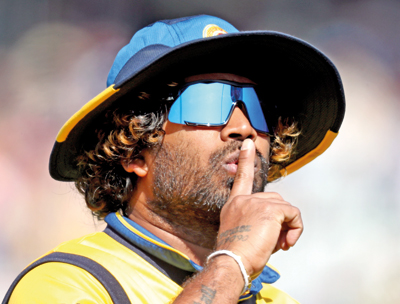“The pressure is all on the bowler”
This year’s IPL boiled down to the last over of the final match. It was an important moment for both Mumbai Indians, the eventual winner, and the Chennai Super Kings, who lost. Nine runs required off the final over. This means it’s anyone’s game. And it was Lasith Malinga that the Mumbai Indians turned to, a man known for his blockbuster spells in world cricket and one who has proven his prowess at the death.
 The first five balls were bowled at an express speed exceeding 140kmh. But with two runs needed off the last ball, Malinga hatched a plan—to come round the wicket and bowl a slow dipping yorker. He was not planning to stop the runs but to take the wicket. That slow dipping yorker crashed into the pads as the batsmen tried to swipe over the leg side. Wild celebrations erupted in the Mumbai camp.
The first five balls were bowled at an express speed exceeding 140kmh. But with two runs needed off the last ball, Malinga hatched a plan—to come round the wicket and bowl a slow dipping yorker. He was not planning to stop the runs but to take the wicket. That slow dipping yorker crashed into the pads as the batsmen tried to swipe over the leg side. Wild celebrations erupted in the Mumbai camp.
“Since I had bowled five fast yorkers, I knew the batsman was expecting me to send down a similar ball in the last delivery,” he recalled.
“So, I decided to bowl a slower yorker coming round the wicket. Then, if he tried to hit it over, it would result in a catch. But I knew if he missed it, I had the option of getting a leg-before decision or getting him bowled. I had these three options and I got the field setting done accordingly.”
Malinga hadn’t bowled round the wicket before and had spent hours practicing at the nets to get it right.
“I was confident because I had control of what I was going to do,” he explained.
“I had spent hours at the nets perfecting the delivery and I only bowled it when I knew I was ready.”
Malinga sends down at least 120 balls at the nets (instead of the usual 24) to perfect this delivery before doing it in a match. At the 44th over of the Australian innings during Sri Lanka’s game against that team at the World Cup, a slow yorker that crashed into the middle stump saw Steve Smith off.
Malinga is a one of the most accomplished yorker bowlers in the world. He does it brilliantly, again and again. Out of his eight scalps at the World Cup so far, three were by ‘yorking’ the batsmen in the death overs. According to CricViz, Malinga has sent down a higher proportion of deliveries as yorkers in this World Cup–5.9 percent. He is only behind Pakistan bowler Mohammed Saifuddin who has a better percentage (6.9) than Malinga.
Malinga’s plan has usually been bowling fuller at the stump. The statistics reaffirm this. They show that, out of eight wickets, five were the result of full deliveries (three yorkers and two leg-before decisions). According to CricViz, 52.7 percent of his deliveries are exclusively full. That is the highest by any bowler at this year’s World Cup.
Bowling at the death is now a serious business unlike before. You need to be decisive. It’s about backing your skills over those of the batsman.

Even the best batsmen in the world are foxed by yorkers shot by the Slinger
“Death bowling is all about how you win certain situations in a match,” Malinga explained. “This requires certain skills. You must have a yorker, a slower ball, a wide yorker, etc. There are different types of balls you can try. Even if you are bowling a slower ball, you must be able to bowl a wide slower ball, if the situation demands it. So, as much as you need the skills, you must be tactically very strong to understand the situation of the match, the ground conditions, the length you must bowl at, the strengths and weaknesses of batsmen you are bowling to, in order to execute your plan. These are some of the key elements that a good death bowler should have.”
“For instance, if the target is 50 runs off the last six overs of the innings, they need to score 25 runs off one bowler,” he elaborated.
“So, we must understand who the bowler is that can restrict them to less than 25 runs. If I can do that, I should make sure I give less than 25 runs, leaving a margin of error for the bowling partner.”
“This what you mean by understanding the situation of the match,” he said.
“This requires a certain level of skill. You need to understand the ground conditions. Whether there’s wind and, if so, from which direction. What are the longest and shortest boundaries in the ground? Who is the batsman who could cause the most damage? We need to understand all these and go to damage control mode.”
“The pressure is all on the bowler to execute and deliver,” Malinga admitted.
“It is hard work and a slightest mistake can be costly.”
A bowler puts himself under pressure if he doesn’t have the skills and tactical knowledge to take the situation under his control.
“If there’s anything called pressure, it comes when you do not have the weapons to meet a specific requirement,” he said.
“In my case, I don’t know what pressure is as I always have what it requires to execute my plan. It’s like when you are driving a car and you need to brake but you realize your brakes are not working. Then, there’s pressure. But if you have brakes, you know when to press the pedal. It’s simple as that.”
Malinga is one of many death bowlers around. Indian Jasprit Bumrah, South Africa’s Kagiso Rabada and Australia’s Mitchell Starc are some of the top ones who have proved decisive to their respective countries at the right time in world cricket.


